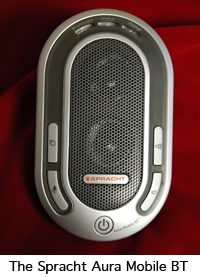Video: Road testing two Bluetooth-based speakerphones -- the VR3 and the Aura

These days, you can't go out in public without bumping into someone that's got some Bluetooth-based gear on their head. You may look funny when appearing to talk into thin air, but the convenience of being able to talk on the phone or listen to music while the phone or music player is still on your belt or in your pocket is liberating. A lot of people also use hands-free headgear in their cars. But what they may not know is that it's often possible to pair their phones with more than one device and then pick which of those devices is the one they want to use at any given time. In the car for example, instead of using Bluetooth headgear, you might want to try using a Bluetooth-based speakerphone.
After gathering up two such devices -- Spracht's $150 Aura Mobile BT and Roadmaster's $70 VR3 -- I decided to take both for a road test. Not only did I test them in the car, we rolled video tape so you could experience the same thing I did. In addition took a bunch of pictures of both devices and loaded them into a ZDNet image gallery to allow for a more intimate look at some of their features and their user interfaces.
 See our video review of the Roadmaster VR3 and Spracht Aura Mobile BT: To get a better idea of how both Bluetooth speakerphones worked, David took to the road in his car and gave both a try and we caught it all on tape. Check out the video to see how things went. See our video review of the Roadmaster VR3 and Spracht Aura Mobile BT: To get a better idea of how both Bluetooth speakerphones worked, David took to the road in his car and gave both a try and we caught it all on tape. Check out the video to see how things went. |  Image Gallery: Want images? Have we got images. We took In addition to the video, we've prepared a gallery of images that shows the two devices up close and personal. Image Gallery: Want images? Have we got images. We took In addition to the video, we've prepared a gallery of images that shows the two devices up close and personal. | |||

In the video review, you'll see that I focus on four basic review criteria:
- How distracting is either device in terms of driver safety.
- Degree of Bluetooth support
- Audio quality (to both the caller and the person on the other end)
- Other features that might attract you to one device over the other
While the video shows me using both devices to place a phone call to a friend who was on a cell phone in New York City, it's really hard for a recording of what's coming out of another speaker to give you a feel of which device sounds better. To be honest, neither device was loud enough for me. If road noise easily penetrates the passenger compartment of your car, you'll find yourself maxing out the volume on both devices and wishing they could go louder. I'm not sure why this is always a problem (not just with these devices, but with many cell phones too). I get the feeling that the devices could go louder if they used better components and it often has me wondering if they were simply looking for a way to save money.
Both devices have rechargeable batteries and both can be mounted to the visor in your car (although the Aura's visor mount, as can be seen in the image gallery, is retractable). If you're in your car, chances are you'll want to always take advantage of the capability of both to receive a charge from the included cigarette lighter adapter (in other words, not run it on the battery since you don't want to have to fidget with power cords while your driving if the battery on either device starts to run low). In this category, the Aura is slightly better because the power jack is on the end of the device that is closest to the windshield when mounted on your visor. In either case, an unsightly wire must be stretched from the lighter up to the unit on the visor. But with the VR3, that wire pokes out the front (facing the driver) rather than the back.
Well, that gives you a taste of my findings. For the rest of the gory details, be sure to check out the video below (which we encourage you to publish on your own web sites and blogs) and the image gallery. To get the embed codes to publish the video on your own site, you can find them on the bottom right hand corner of this Webshots page.